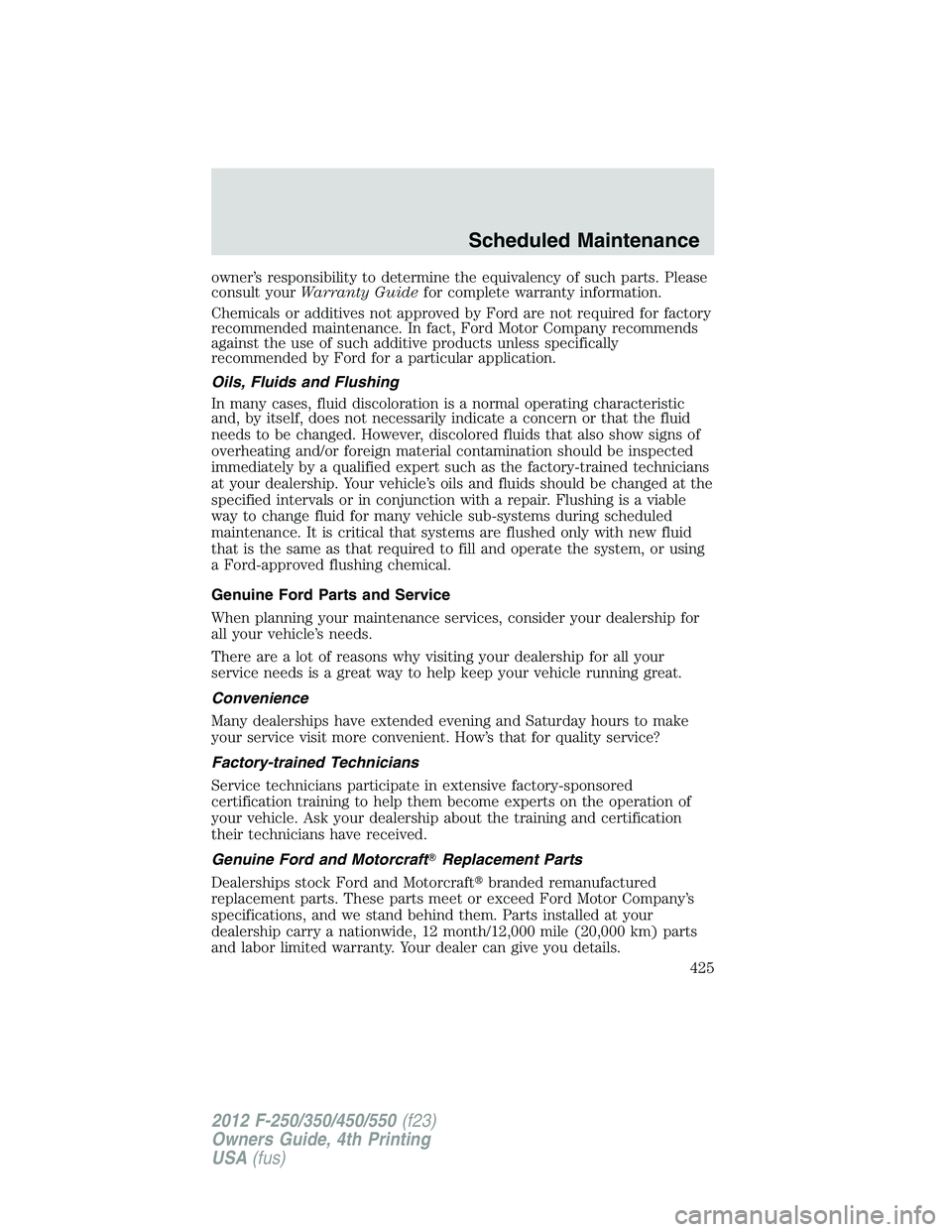Page 385 of 448

3. If this is not possible, wait a short period for the engine to cool.
4. Check the coolant level and replenish if low.
WARNING: Never remove the coolant reservoir cap while the
engine is running or hot.
5. Re-start the engine and take your vehicle to an authorized dealer.
Driving the vehicle without repairing the engine problem
increases the chance of engine damage. Take your vehicle to an
authorized dealer as soon as possible.
Engine fluid temperature management (except 6.8L V10)
Your vehicle has been designed to pull a trailer, but because of the added
load, the vehicle’s engine may temporarily reach higher temperatures
during severe operating conditions such as ascending a long or steep
grade while pulling a trailer in hot ambient temperatures.
At this time, you may notice your engine coolant temperature gauge
needle move toward the H and the POWER REDUCED TO LOWER
TEMP message may appear on the message center.
You may notice a reduction in the vehicle’s speed caused by reduced
engine power. Your vehicle has been designed to enter this mode if
certain high temperature/high load conditions take place in order to
manage the engine’s fluid temperatures. The amount of speed reduction
will depend on the vehicle loading, towing, grade, ambient temperature,
and other factors. If this occurs, there is no need to pull off the road.
The vehicle can continue to be driven while this message is active.
WARNING: To reduce the risk of collision and injury, be
prepared that the vehicle speed may reduce and the vehicle may
not be able to accelerate with full power until the fluid temperatures
reduce.
The air conditioning may also cycle on and off during severe operating
conditions to protect overheating of the engine. When the engine coolant
temperature decreases to a more normal operating temperature, the air
conditioning will turn on once again.
If you notice any of the following:
• the engine coolant temperature gauge moves fully into the red (hot)
area
• the coolant temperature warning light illuminates Maintenance and Specifications
385
2012 F-250/350/450/550 (f23)
Owners Guide, 4th Printing
USA (fus)
Page 402 of 448
Correct fluid level
For vehicles equipped with 5-speed transmissions, the fluid should be
checked at normal operating temperature 150°F-170°F (66°C-77°C) on a
level surface. For vehicles equipped with 6-speed transmissions, the fluid
should be checked at normal operating temperature 196°F-216°F
(91°C-102°C) on a level surface. The normal operating temperature can
be reached after approximately 20 miles (30 km) of driving.
Type A
Type B
High fluid level
Type A
Type B
Fluid levels above the safe range may result in transmission failure. An
overfill condition of transmission fluid may cause shift and/or
engagement concerns and/or possible damage.
High fluid levels can be caused by an overheating condition. ADD COLD HOT DO NOT ADD
ADD COLD HOT DO NOT ADD
Maintenance and Specifications
402
2012 F-250/350/450/550 (f23)
Owners Guide, 4th Printing
USA (fus)
Page 425 of 448

owner’s responsibility to determine the equivalency of such parts. Please
consult your Warranty Guide for complete warranty information.
Chemicals or additives not approved by Ford are not required for factory
recommended maintenance. In fact, Ford Motor Company recommends
against the use of such additive products unless specifically
recommended by Ford for a particular application.
Oils, Fluids and Flushing
In many cases, fluid discoloration is a normal operating characteristic
and, by itself, does not necessarily indicate a concern or that the fluid
needs to be changed. However, discolored fluids that also show signs of
overheating and/or foreign material contamination should be inspected
immediately by a qualified expert such as the factory-trained technicians
at your dealership. Your vehicle’s oils and fluids should be changed at the
specified intervals or in conjunction with a repair. Flushing is a viable
way to change fluid for many vehicle sub-systems during scheduled
maintenance. It is critical that systems are flushed only with new fluid
that is the same as that required to fill and operate the system, or using
a Ford-approved flushing chemical.
Genuine Ford Parts and Service
When planning your maintenance services, consider your dealership for
all your vehicle’s needs.
There are a lot of reasons why visiting your dealership for all your
service needs is a great way to help keep your vehicle running great.
Convenience
Many dealerships have extended evening and Saturday hours to make
your service visit more convenient. How’s that for quality service?
Factory-trained Technicians
Service technicians participate in extensive factory-sponsored
certification training to help them become experts on the operation of
your vehicle. Ask your dealership about the training and certification
their technicians have received.
Genuine Ford and Motorcraft � Replacement Parts
Dealerships stock Ford and Motorcraft � branded remanufactured
replacement parts. These parts meet or exceed Ford Motor Company’s
specifications, and we stand behind them. Parts installed at your
dealership carry a nationwide, 12 month/12,000 mile (20,000 km) parts
and labor limited warranty. Your dealer can give you details. Scheduled Maintenance
425
2012 F-250/350/450/550 (f23)
Owners Guide, 4th Printing
USA (fus)